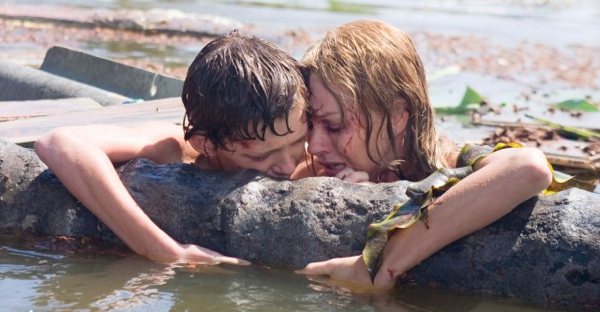Movie review by Greg Carlson
A troubled, manipulative disaster spectacle with a problematic point-of-view, “The Impossible” imagines the 2004 Indian Ocean earthquake through the eyes of a wealthy white family whose Christmas vacation is interrupted by a horrific natural catastrophe that would become – based on total lives lost – the worst tsunami in recorded history. Long on the powerful emotions that come with the woman-versus-nature conflict and short on the vision that would provide a breadth of context for the estimated quarter million dead, “The Impossible” employs state-of-the-art special effects to accomplish one of the bizarre things big-budget filmmaking manages so well: placing the viewer with uncanny verisimilitude inside the heart of an event nobody would want to experience firsthand.
Unlike several of the disaster-suspense thrillers popular in the 1970s, “The Impossible” skips the narrative device in which a large group of survivors representing a variety of economic backgrounds is followed, instead turning its attention to the five members that make up the nuclear Bennett family (their nationality switched from Spanish). Considering the events depicted in the film occur in Thailand, director Juan Antonia Bayona makes a colossal error in virtually ignoring the native inhabitants in favor of the tourists. Structurally, the movie divides its time between Naomi Watts’ seriously injured Maria, who manages to stay with oldest son Lucas, while Ewan McGregor’s panic-stricken Henry looks after the two youngest brothers.
Clint Eastwood’s weird 2010 misfire “Hereafter” dramatized the same historical event in one of its interlocking storylines, and the depiction of the tsunami’s arrival in that film earned an Academy Award nomination for Best Visual Effects. Given its greater emphasis on the particulars of the disaster and the skill with which the filmmakers imagine it, “The Impossible” is almost certain to replicate that feat. The HBO/BBC miniseries “Tsunami: The Aftermath,” another fictionalized account of the earthquake, attempted to tackle wider political issues, but like “The Impossible,” was criticized for its lack of interest in the flood’s native victims.
Regardless of its “true story” pedigree, “The Impossible” stumbles with several scenes and moments that throb with naivete, condescension, or both. Worst among these artless insults is a nighttime reverie in which Geraldine Chaplin, who also appeared in Bayona’s effective horror-suspense nightmare “The Orphanage,” discusses the life and death of stars while comforting one of Bennett boys. Another trick, de rigueur in the genre, demands a few split-second near-misses as the family members come within an eyelash of reuniting in the chaos of the disaster’s aftermath. Predictably, there are also instances of cruel selfishness interspersed with moments of generosity and compassion.
Even though more award season buzz has been directed toward Watts than McGregor, the talented performer’s onscreen time is limited by her character’s predicament: a life-threatening leg gash that places Maria at the threshold of death’s door once the adrenalized rush of negotiating the roiling hell is surmounted. While McGregor is given a juicy scene in which he places an emotional phone call, Watts spends the second half of the film in pre-surgical limbo (as Kevin Jagernauth effectively puts it, “If there is an Oscar for moaning in pain, Watts will certainly be a lock”). Similarly, the viewer is immobilized, in shock and feeling helpless until “The Impossible” fulfills the promise of its title.
